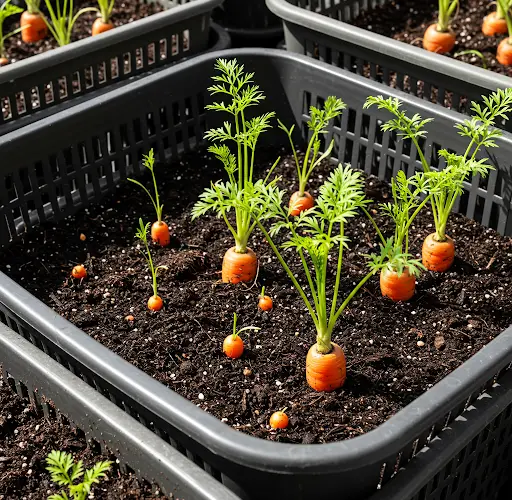How to Grow Carrots at Home – Simple and Fresh All Year Round
Carrots are a versatile and healthy root vegetable that you can easily grow at home, even without a large garden. Their crisp texture, vibrant color, and sweet flavor make them a kitchen favorite—whether eaten raw, steamed, roasted, or added to soups and salads. The best part? You can grow carrots in containers, bags, or garden beds throughout the year, enjoying fresh, clean harvests every season.
With the right technique, you’ll never have to rely on store-bought carrots again. Growing your own is not only satisfying but also ensures that you’re eating vegetables free from chemicals and picked at peak freshness.
Why Grow Carrots at Home?
-
Compact and adaptable: Carrots don’t need a lot of space, making them ideal for balconies, patios, or small garden plots.
-
Low maintenance: Once planted, they grow quietly underground with minimal fuss.
-
Clean and fresh: Homegrown carrots are cleaner, sweeter, and more flavorful than most supermarket varieties.
-
Year-round potential: With the right variety and setup, you can enjoy continuous harvests across seasons.
What You’ll Need
To start growing carrots at home, you’ll need the following:
-
Carrot seeds (choose a suitable variety for your climate and container depth)
-
Containers, grow bags, or a patch of loose garden soil
-
Potting mix or sandy, well-draining soil
-
Compost or organic fertilizer
-
Watering can or hose
-
A sunny location (carrots need 6–8 hours of sunlight daily)
Optional: mulch or shade cloth (especially in hot summer months).
Step-by-Step Guide to Growing Carrots
1. Choose the Right Variety
Carrots come in many shapes and sizes. For home growing, especially in containers, shorter varieties are often the easiest to manage. Look for:
-
Thumbelina: A round, small carrot perfect for shallow containers
-
Nantes: A sweet, cylindrical variety good for most conditions
-
Danvers: A classic tapered type that works well in loose garden beds
Choose a variety suited to your soil depth and climate for best results.
2. Prepare the Soil or Containers
Carrots thrive in soft, loose soil that allows their roots to grow straight and deep. Avoid clay-heavy or rocky soil, which can cause carrots to split or fork.
If planting in containers:
-
Choose pots or bags at least 10–12 inches deep.
-
Fill with a mix of potting soil and sand or compost to create a light, well-drained medium.
-
Avoid using manure-heavy soil, which can cause root deformation.
Loosen garden soil thoroughly if planting directly in the ground.
3. Sow the Seeds
Sow carrot seeds directly into the soil—they do not transplant well.
-
Scatter seeds thinly about 1/4 inch deep.
-
Space rows about 6–8 inches apart.
-
Gently cover with a fine layer of soil and mist with water.
Carrot seeds are slow to germinate, often taking 1–3 weeks. Keep the soil consistently moist during this time.
4. Thin the Seedlings
Once seedlings reach about 2 inches tall, thin them to about 2–3 inches apart. Thinning is essential—overcrowded carrots compete for space and nutrients, resulting in small or misshapen roots.
Use scissors or pinch off the tops instead of pulling to avoid disturbing nearby plants.
5. Watering and Care
Keep the soil evenly moist but not soggy. Carrots need steady moisture, especially during root development, to avoid becoming woody or bitter.
Water deeply 2–3 times per week, depending on weather. Use mulch to retain moisture and keep the soil cool in summer.
Avoid heavy feeding—too much nitrogen promotes leafy tops instead of healthy roots. A light application of compost tea or organic vegetable fertilizer every few weeks is sufficient.
6. Sunlight and Seasonal Timing
Carrots prefer full sun but can tolerate light shade, especially in hot climates.
You can grow carrots year-round in many regions by staggering your planting every 3–4 weeks. In cooler areas, start in early spring and late summer for fall harvests. In milder climates, winter crops grow especially well with fewer pest problems.
7. Harvesting Carrots
Most carrot varieties are ready to harvest 60–80 days after planting. Signs they’re ready include:
-
The top of the carrot pushing up through the soil
-
Bright, full green tops
-
A firm, smooth root when you gently tug
Harvest by loosening the soil and pulling the carrot straight up. Brush off excess dirt and enjoy immediately or store in the fridge.
Growing Tips for Success
-
Water regularly: Uneven watering can cause cracking.
-
Avoid disturbing the roots: Carrots grow best when left alone.
-
Try succession planting: Plant small batches every few weeks for a continuous supply.
-
Use deep containers: Especially for longer varieties.
Final Thoughts
Growing carrots at home is a simple and satisfying way to enjoy fresh, healthy vegetables all year round. With just a bit of care and the right soil, you can grow clean, crunchy carrots right from your balcony, backyard, or kitchen corner. This method is perfect for beginners and seasoned gardeners alike—proof that home gardening doesn’t have to be complicated to be rewarding.
Whether you’re looking to reduce food waste, save money, or just enjoy the taste of homegrown food, carrots are a great crop to grow and harvest season after season.



